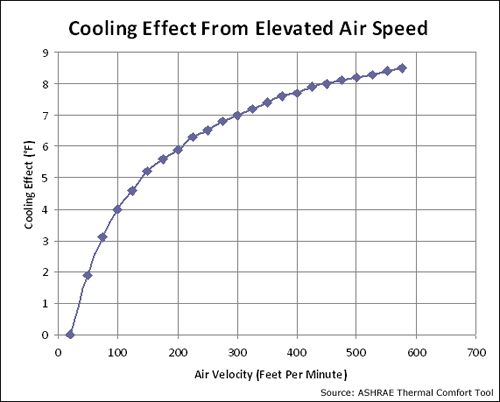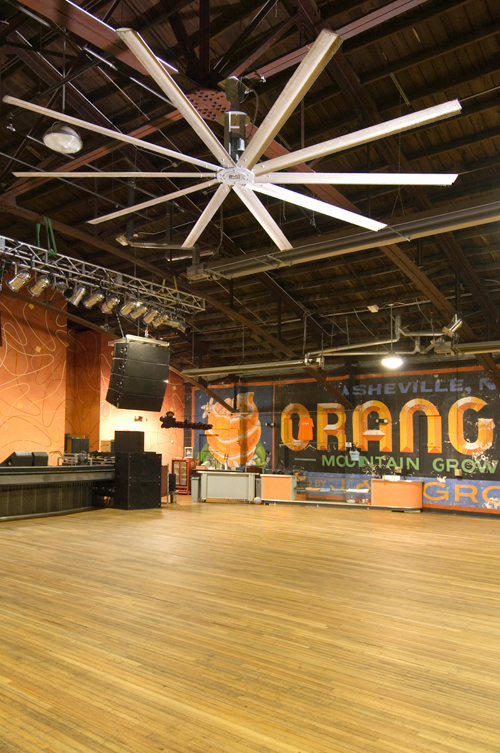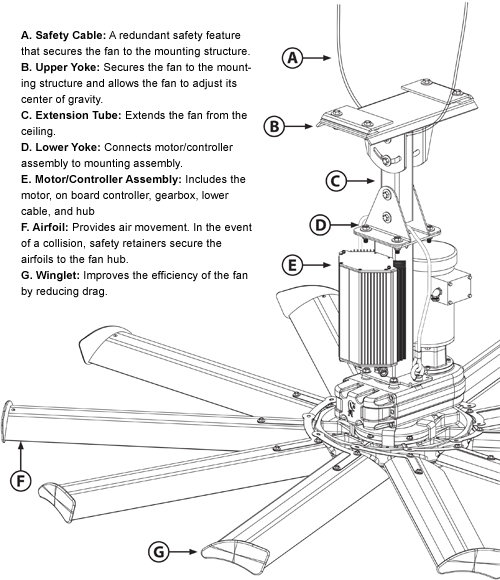Large, Low Velocity Fans: Making Energy Efficiency a Breeze
Energy Costs
Energy costs for a large, low velocity fan are low compared to the most commonly utilized method of providing occupant thermal comfort, the traditional HVAC system. A 12-foot commercial fan running at full speed uses approximately .6 kilowatts (kW) and provides cooling for approximately 3,600 square feet. The same fan operating at two-third speed, which is a more typical speed for an office area, uses approximately 0.2 kW. In destratification mode, which is one-third speed, the same fan uses less than 0.1 kW. The energy savings using large, low velocity fans in air conditioned spaces are provided by resetting the thermostat up because of the cooling effect created by air velocity. One degree of thermostat reset equals a 3 to 4 percent reduction in cooling energy consumption. In an air conditioned space in the summer and/or the energy savings provided by destratifying a heated space in the winter will be dramatically greater than the cost of operating the fans.
 |
The cooling effect of gentle air movement creates an effective temperature reduction of 8-10° F, permitting an increase in thermostat settings without loss of comfort. Source: ASHRAE's Thermal Comfort Tool. Photo Courtesy of Big Ass Fans® |
Potential for LEED Points
Large, low velocity ceiling fans have the potential to help earn Leadership in Energy and Environmental Design (LEED) points from the United States Green Building Council, which encourages and accelerates global adoption of sustainable green building and development practices. Large, low velocity ceiling fans may be part of a design strategy that earns points in the Energy and Atmosphere, Innovation in Design, and Indoor Environmental Quality LEED categories. As a general rule, no single product can earn a point or meet the requirements of a prerequisite; the product is generally part of a system or overall strategy that earns the points or meets the requirements of the prerequisite. Ask the manufacturer for a detailed account of LEED credits that fans can be applied towards.
 |
Large, low velocity fans took the place of air-conditioning at this North Carolina cultural center. Photo Courtesy of Big Ass Fans® |
Installation
While installation instructions may vary by manufacturer, some benchmarks apply. Mounting bolts should use steel in a sheer strength of 400 pounds — or about three times the sheer force that even the strongest fans can create. Using locking nuts can prevent the nuts and bolts from loosening during operation. Precision extruded aluminum foils provide a rigid yet lightweight assembly. To keep the foils in place, airfoil retainers can be fastened to the hub by three locking bolts. Choosing a manufacturer with standardized processes, certifications or merits, such as ISO certification and UL listing of products (instead of individual components), can provide assurance of safety as well as quality. Always inquire about the testing processes and procedures to ensure the fan(s) you choose meets the rigorous design standards set forth by industry experts.
Multiple Features Ensure Safe Operation |
 |
Image Courtesy Big Ass Fans® |









